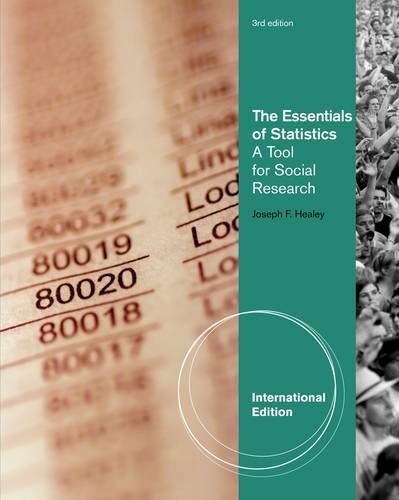
The Essentials of Statistics 3rd Edition by Joseph Healey
Edition 3ISBN: 978-1111831585
The Essentials of Statistics 3rd Edition by Joseph Healey
Edition 3ISBN: 978-1111831585 Exercise 1
PS: Why does voter turnout vary from election to election? For municipal elections in five different cities, information has been gathered on the percentage of registered voters who actually voted, unemployment rate, average years of education for the city, and the percentage of all political ads that used "negative campaigning" (personal attacks, negative portrayals of the opponent's record, etc.). For each relationship:
a. Draw a scattergram and a freehand regression line.
b. Compute the slope (b) and then find the Y intercept (a). (Hint: Remember to compute b before computing a. A computing table like Table 13.3 is highly recommended.)
c. State the least-squares regression line and then predict the voter turnout for a city in which the unemployment rate was 12%-a city in which the average years of schooling was 11, and a city that had an election in which 90% of the ads were negative.
d. Compute r and r 2. (Hint: A computing table like Table 13.4 is highly recommended. If you constructed one for computing b, you already have most of the quantities you will need to solve for r.)
e. Describe the strength and direction of each relationship in a sentence or two. Which factor had the strongest effect on turnout?
Turnout and Unemployment

Turnout and Level of Education

Turnout and Negative Campaigning



a. Draw a scattergram and a freehand regression line.
b. Compute the slope (b) and then find the Y intercept (a). (Hint: Remember to compute b before computing a. A computing table like Table 13.3 is highly recommended.)
c. State the least-squares regression line and then predict the voter turnout for a city in which the unemployment rate was 12%-a city in which the average years of schooling was 11, and a city that had an election in which 90% of the ads were negative.
d. Compute r and r 2. (Hint: A computing table like Table 13.4 is highly recommended. If you constructed one for computing b, you already have most of the quantities you will need to solve for r.)
e. Describe the strength and direction of each relationship in a sentence or two. Which factor had the strongest effect on turnout?
Turnout and Unemployment

Turnout and Level of Education

Turnout and Negative Campaigning



Explanation
Let the variable be the turnout.
The va...
The Essentials of Statistics 3rd Edition by Joseph Healey
Why don’t you like this exercise?
Other Minimum 8 character and maximum 255 character
Character 255


